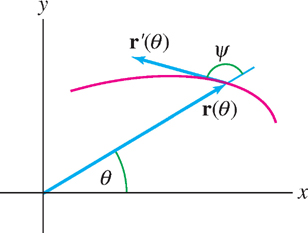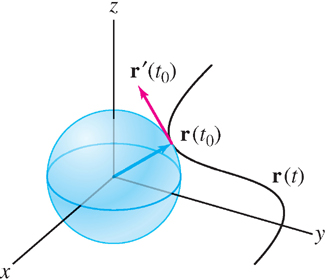Exercises
In Exercises 1–
Question 13.59

Question 13.60

Question 13.61

Question 13.62

Question 13.63
Evaluate  for
for  .
.
Question 13.64
Evaluate  for r(t) = 〈sin t, 1 − cos t, −2t〉.
for r(t) = 〈sin t, 1 − cos t, −2t〉.
In Exercises 7–
Question 13.65
r(t) = 〈t, t2, t3〉
Question 13.66

Question 13.67
r(t) = 〈e3s, e−s, s4〉
Question 13.68

Question 13.69
c(t) = t−1i − e2t k
739
Question 13.70
a(θ) = (cos 3θ)i + (sin2 θ)j + (tan θ)k
Question 13.71
Calculate r′(t) and r″(t) for r(t) = 〈t, t2, t3〉.
Question 13.72
Stetch the curve r(t) = 〈1 − t2, t〉 for −1 ≤ t ≤ 1. Compute the tangent vector at t = 1 and add it to the sketch.
Question 13.73
Stetch the curve r1(t) = 〈t, t2〉 together with its tangent vector at t = 1. Then do the same for r2(t) = 〈t3, t6〉.
Question 13.74
Sketch the cycloid r(t) = 〈t − sin t, 1 − cos t〉 together with its tangent vectors at  and
and  .
.
In Exercises 17–

Question 13.75

Question 13.76

Question 13.77

Question 13.78
 , assuming that
, assuming that

In Exercises 21 and 22, let

Question 13.79
Compute  in two ways:
in two ways:
Calculate r1(t) · r2(t) and differentiate.
Use the Product Rule.
Question 13.80
Compute  in two ways:
in two ways:
Calculate r1(t) × r2(t) and differentiate.
Use the Product Rule.
In Exercises 23– using the Chain Rule.
using the Chain Rule.
Question 13.81

Question 13.82

Question 13.83

Question 13.84

Question 13.85
Let r(t) = 〈t2, 1 − t, 4t〉. Calculate the derivative of r(t) · a(t) at t = 2, assuming that a(2) = 〈1, 3, 3〉 and a′(2) = 〈−1, 4, 1〉.
Question 13.86
Let v(s) = s2i + 2sj + 9s−2k. Evaluate  at s = 4, assuming that g(4) = 3 and g′(4) = −9.
at s = 4, assuming that g(4) = 3 and g′(4) = −9.
In Exercises 29–
Question 13.87

Question 13.88

Question 13.89

Question 13.90

Question 13.91

Question 13.92

Question 13.93
Use Example 4 to calculate  , where r(t) = 〈?t, t2, et〉.
, where r(t) = 〈?t, t2, et〉.
Question 13.94
Let r(t) = 〈3 cos t, 5 sin t, 4 cos t〉. Show that ∥r(t)∥ is constant and conclude, using Example 7, that r(t) and r′(t) are orthogonal. Then compute r′(t) and verify directly that r′(t) is orthogonal to r(t).
Question 13.95
Show that the derivative of the norm is not equal to the norm of the derivative by verifying that ∥r(t)∥′ ≠ ∥r(t)′∥ for r(t) = 〈t, 1, 1〉.
Question 13.96
Show that  for any constant vector a.
for any constant vector a.
In Exercises 39–
Question 13.97

Question 13.98

Question 13.99

Question 13.100

Question 13.101

Question 13.102

Question 13.103

Question 13.104

In Exercises 47–
Question 13.105

Question 13.106

Question 13.107

Question 13.108

Question 13.109

Question 13.110

Question 13.111

Question 13.112

Question 13.113
Find the location at t = 3 of a particle whose path (Figure 8) satisfies


740
Question 13.114
Find the location and velocity at t = 4 of a particle whose path satisfies

Question 13.115
A fighter plane, which can shoot a laser beam straight ahead, travels along the path r(t) = 〈5 − t, 21 − t2, 3 − t3/27〉. Show that there is precisely one time t at which the pilot can hit a target located at the origin.
Question 13.116
The fighter plane of Exercise 57 travels along the path r(t) = 〈t − t3, 12 − t2, 3 − t〉. Show that the pilot cannot hit any target on x-axis.
Question 13.117
Find all solutions to r′(t) = v with initial condition r(1) = w, where v and w are constant vectors in R3.
Question 13.118
Let u be a constant vector in R3. Find the solution of the equation r′(t) = (sin t)u satisfying r′(0) = 0.
Question 13.119
Find all solutions to r′(t) = 2r(t) where r(t) is a vector-
Question 13.120
Show that w(t) = 〈sin(3t + 4), sin(3t − 2), cos 3t〉 satisfies the differential equation w″(t) = −9w(t).
Question 13.121
Prove that the Bernoulli spiral (Figure 9) with parametrization r(t) = 〈et cos 4t, et sin 4t〉 has the property that the angle ψ between the position vector and the tangent vector is constant. Find the angle ψ in degrees.

Question 13.122
A curve in polar form r = f(θ) has parametrization
r(θ) = f(θ) 〈cos θ, sin θ〉
Let ψ be the angle between the radial and tangent vectors (Figure 10). Prove that


Hint: Compute r(θ) × r′(θ) and r(θ) · r′(θ).
Question 13.123
 Prove that if ∥r(t)∥ takes on a local minimum or maximum value at t0, then r(t0) is orthogonal to r′(t0). Explain how this result is related to Figure 11. Hint: Observe that if ∥r(t0)∥ is a minimum, then r(t) is tangent at t0 to the sphere of radius ∥r(t0)∥ centered at the origin.
Prove that if ∥r(t)∥ takes on a local minimum or maximum value at t0, then r(t0) is orthogonal to r′(t0). Explain how this result is related to Figure 11. Hint: Observe that if ∥r(t0)∥ is a minimum, then r(t) is tangent at t0 to the sphere of radius ∥r(t0)∥ centered at the origin.

Question 13.124
Newton’s Second Law of Motion in vector form states that  where F is the force acting on an object of mass m and p = mr′(t) is the object’s momentum. The analogs of force and momentum for rotational motion are the torque τ = r × F and angular momentum
where F is the force acting on an object of mass m and p = mr′(t) is the object’s momentum. The analogs of force and momentum for rotational motion are the torque τ = r × F and angular momentum
J = r(t) × p(t)
Use the Second Law to prove that  .
.